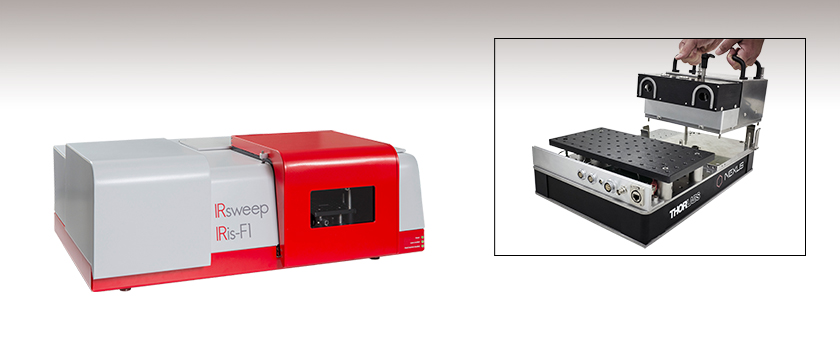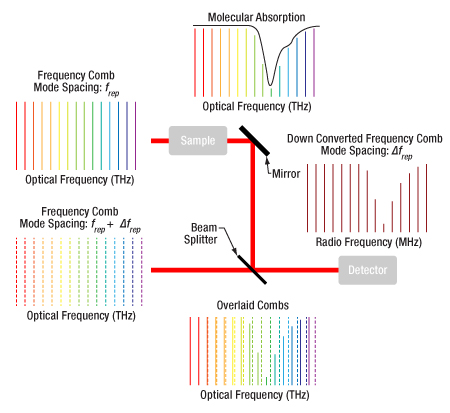IRsweep Dual-Frequency-Comb Spectrophotometers

- Dual-Frequency-Comb Spectrophotometers in the Long-Wave Infrared
- Quantum Cascade Laser Frequency Comb Sources
- Sources Available from 1800 cm-1 to 900 cm-1 (5.6 - 11 μm)
- 4 μs Acquisition Time Per Spectrum
Both the IRis-F1 and IRis-Core spectrophotometers feature user exchangeable quantum cascade laser frequency comb modules that allow for study from 1800 cm-1 to 900 cm-1 with a typical bandwidth of 60 cm-1 each. The unenclosed form factor of the IRis-Core spectrophotometer enables integration into existing experimental setups.

Please Wait
| Representitive Specificationsa | |||
|---|---|---|---|
| Parameters | Typical | ||
| Time Resolution | 4 µsb | ||
| Signal-to-Noise Ratio | >100 at 1 µs Integration Time | ||
| >1000 at 100 µs Integration Time | |||
| >25 000 at 1 s Integration Time | |||
| Light Source | Exchangable Quantum Cascade Laser Frequency Combs | ||
| Light Source Center Wavelength | 1800 cm-1 to 900 cm-1 (5.6 - 11 μm) | ||
| Spectral Coverage Per Source | 60 cm-1 | ||
| Spectral Resolution (Standard Mode) |
0.25 - 0.5 cm-1 (8 - 15 GHz) | ||
| Spectral Resolution (High Resolution Mode) |
<0.0003 cm-1 (<10 MHz) | ||
| Dimensions (IRis-F1) | 78 cm x 57 cm x 28 cm (31" x 22" x 11") |
||
| Dimensions (IRis-Core) | 45 cm x 30 cm x 28 cm (18" x 12" x 11") |
||

Reza Salem
Business Unit Leader, Fiber Lasers

Click to Enlarge
Superimposing two optical frequency combs with different mode spacings allows for the down conversion of the optical spectrum to the radio frequency regime, which can be read by a photodiode, thus recovering the optical absorption spectrum of the sample.
Features
- Exchangeable Quantum Cascade Laser Frequency Comb Modules
- 60 cm-1 Typical Bandwidth per Module
- Modules Available from 1800 cm-1 to 900 cm-1 (5.6 - 11 μm)
- Spectral Resolution:
- Standard Resolution Mode: 0.25 - 0.5 cm-1
- High Resolution Mode: <0.0003 cm-1
- Thermoelectrically Cooled Mercury Cadmium Telluride Detectors
- Included in the IRis-F1 Spectrophotometer
- Optional Add-On for the IRis-Core Spectrophotometer
- 4 μs Acquisition Time Per Spectrum
- Beam Can Be Coupled to External Experiments
Applications
- Fingerprint Region Molecular Spectroscopy
- Chemical Kinetics and Dynamics
- Photocatalysis
- Protein Dynamics
- Stopped-Flow Spectroscopy
- Spectroelectrochemistry
The IRsweep dual-frequency-comb spectrophotometers enable time-resolved, fingerprint-region absorption spectroscopy in turnkey, easy-to-use instruments. Made possible via a license and technology transfer, the patented dual-frequency-comb measurement technique employs user-exchangeable quantum cascade laser pairs designed to produce frequency combs. These broadband sources typically have a bandwidth of approximately 60 cm-1 and provide access to regions of the long-wave infrared spectrum from 1800 cm-1 to 900 cm-1 (5.6 - 11 μm) with a standard spectral resolution of 0.25 -0.5 cm-1. A high-resolution mode allows spectra to be acquired with a spectral resolution as fine as 0.0003 cm-1, at the expense of longer acquisition time, ideal for resolving detailed structure in gas-phase samples.
The broadband frequency combs allow for simultaneous observation of multiple spectral peaks, making detection and tracking of multiple species within a sample or the evolution of a species possible. Spectra are recorded sequentially in just 4 μs each with superior signal-to-noise compared to traditional Fourier transform infrared (FTIR) spectrometers, enabling time-resolved fingerprint region spectroscopy.
Dual-Frequency-Comb Spectroscopy
An optical frequency comb is a set of equally spaced narrow lines in the frequency domain characterized by the expression f (n) = f0 + nfrep where f0 is the frequency offset, n is an integer, and frep is the frequency difference between adjacent lines, called the mode spacing. Frequency combs can be generated by a variety of sources including quantum cascade lasers. Quantum cascade lasers have the advantage of being compact, solid-state sources that can emit in the long-wave infrared region of the electromagnetic spectrum.
By superimposing two optical frequency combs with slightly different mode spacings, an optical absorption spectrum can be transposed into the radio frequency regime. A fast photodiode can thus measure the resultant heterodyne beating pattern. Upon Fourier transforming the signal from the photodiode, the optical absorption spectrum can be recovered. This method is advantageous compared to more common FTIR spectrometers because it has no moving parts and measures the entire spectrum in the timeframe of 1/Δfrep, typically on the order of microseconds, allowing for time-resolved spectroscopy on rapidly evolving samples or reactions. Furthermore, unlike an FTIR spectrometer, a dual-comb spectrometer doesn't impart an instrument-specific line spread function onto the spectrum that must be deconvolved to recover the true spectrum.
IRis-F1 Spectrophotometer
The IRis-F1 spectrophotometer is a turnkey package in a benchtop form factor. With an integrated and enclosed sample compartment, the IRis-F1 fully contains the experimental setup and shields the beamline from source to detection for a safe, easy to use instrument. The large 27 x 27 cm (11" x 11") sample compartment with an integrated breadboard allows for coupling to many existing accessories such as attenuated total reflection (ATR) units, transmission cells, and reflection setups.
The pair of high-bandwidth and high-sensitivity, thermoelectrically-cooled, mercury-cadmium-telluride detectors allows for fast data acquisition and don't require liquid nitrogen cooling. Standard spectral acquisition time is 4 μs with the ability to go down to 1 μs with manual post-processing. Spectra are acquired sequentially with no downtime between acquisitions. This continuous acquisition results in a single integrated measurement block of up to 130 ms composed of as many as 32,500 sequentially measured spectra, providing insight into reaction dynamics on the microsecond timescale. Due to recording individual spectra on the microsecond timescale rather than integrating continuously, shot-to-shot changes like photobleaching, baseline shifts, and thermal effects can be monitored. Measurement blocks can be recorded with good signal-to-noise for time-resolved spectroscopy from the millisecond to the minute regime.
IRis-Core Spectrophotometer
The IRis-Core spectrophotometer uses the same quantum cascade laser frequency comb sources as the IRis-F1 spectrophotometer but does not include detectors as standard, allowing for the use of application-specific detectors. An optional detection package is available to provide the IRis-Core system with the same performance as the IRis-F1 system. The IRis-Core spectrophotometer is packaged on a smaller, unenclosed 30 x 45 cm (12" x 18") Nexus® breadboard making it ideal for integrating into larger optical setups. The secondary 15 x 30 cm (6" x 12") aluminum breadboard provides a flexible workspace for constructing experimental setups.
| Posted Comments: | |
| No Comments Posted |
 Products Home
Products Home





 IRsweep Spectrophotometers
IRsweep Spectrophotometers